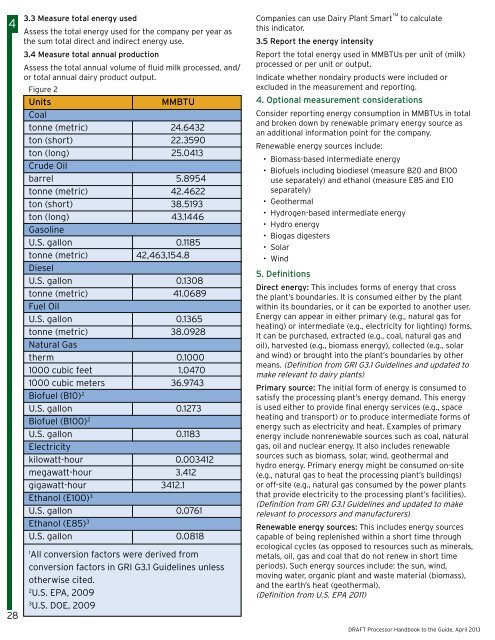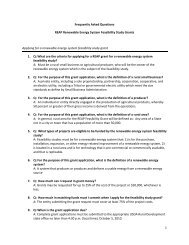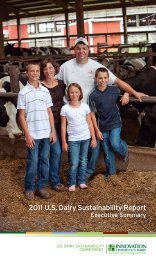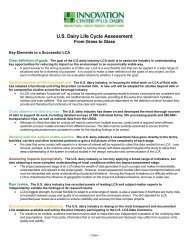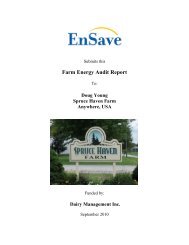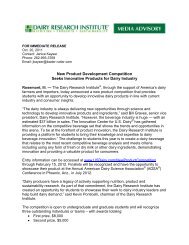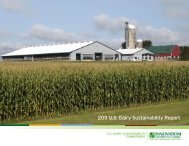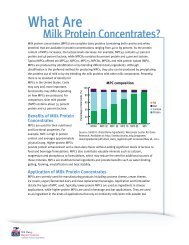Processor Handbook - Innovation Center for US Dairy
Processor Handbook - Innovation Center for US Dairy
Processor Handbook - Innovation Center for US Dairy
You also want an ePaper? Increase the reach of your titles
YUMPU automatically turns print PDFs into web optimized ePapers that Google loves.
4<br />
28<br />
3.3 Measure total energy used<br />
Assess the total energy used <strong>for</strong> the company per year as<br />
the sum total direct and indirect energy use.<br />
3.4 Measure total annual production<br />
Assess the total annual volume of fluid milk processed, and/<br />
or total annual dairy product output.<br />
Figure 2<br />
Units<br />
MMBTU<br />
Coal<br />
tonne (metric) 24.6432<br />
ton (short) 22.3590<br />
ton (long) 25.0413<br />
Crude Oil<br />
barrel 5.8954<br />
tonne (metric) 42.4622<br />
ton (short) 38.5193<br />
ton (long) 43.1446<br />
Gasoline<br />
U.S. gallon 0.1185<br />
tonne (metric) 42,463,154.8<br />
Diesel<br />
U.S. gallon 0.1308<br />
tonne (metric) 41.0689<br />
Fuel Oil<br />
U.S. gallon 0.1365<br />
tonne (metric) 38.0928<br />
Natural Gas<br />
therm 0.1000<br />
1000 cubic feet 1.0470<br />
1000 cubic meters 36.9743<br />
Biofuel (B10) 2<br />
U.S. gallon 0.1273<br />
Biofuel (B100) 2<br />
U.S. gallon 0.1183<br />
Electricity<br />
kilowatt-hour 0.003412<br />
megawatt-hour 3.412<br />
gigawatt-hour 3412.1<br />
Ethanol (E100) 3<br />
U.S. gallon 0.0761<br />
Ethanol (E85) 3<br />
U.S. gallon 0.0818<br />
1<br />
All conversion factors were derived from<br />
conversion factors in GRI G3.1 Guidelines unless<br />
otherwise cited.<br />
2<br />
U.S. EPA, 2009<br />
3<br />
U.S. DOE, 2009<br />
Companies can use <strong>Dairy</strong> Plant Smart TM to calculate<br />
this indicator.<br />
3.5 Report the energy intensity<br />
Report the total energy used in MMBTUs per unit of (milk)<br />
processed or per unit or output.<br />
Indicate whether nondairy products were included or<br />
excluded in the measurement and reporting.<br />
4. Optional measurement considerations<br />
Consider reporting energy consumption in MMBTUs in total<br />
and broken down by renewable primary energy source as<br />
an additional in<strong>for</strong>mation point <strong>for</strong> the company.<br />
Renewable energy sources include:<br />
• Biomass-based intermediate energy<br />
• Biofuels including biodiesel (measure B20 and B100<br />
use separately) and ethanol (measure E85 and E10<br />
separately)<br />
• Geothermal<br />
• Hydrogen-based intermediate energy<br />
• Hydro energy<br />
• Biogas digesters<br />
• Solar<br />
• Wind<br />
5. Definitions<br />
Direct energy: This includes <strong>for</strong>ms of energy that cross<br />
the plant’s boundaries. It is consumed either by the plant<br />
within its boundaries, or it can be exported to another user.<br />
Energy can appear in either primary (e.g., natural gas <strong>for</strong><br />
heating) or intermediate (e.g., electricity <strong>for</strong> lighting) <strong>for</strong>ms.<br />
It can be purchased, extracted (e.g., coal, natural gas and<br />
oil), harvested (e.g., biomass energy), collected (e.g., solar<br />
and wind) or brought into the plant’s boundaries by other<br />
means. (Definition from GRI G3.1 Guidelines and updated to<br />
make relevant to dairy plants)<br />
Primary source: The initial <strong>for</strong>m of energy is consumed to<br />
satisfy the processing plant’s energy demand. This energy<br />
is used either to provide final energy services (e.g., space<br />
heating and transport) or to produce intermediate <strong>for</strong>ms of<br />
energy such as electricity and heat. Examples of primary<br />
energy include nonrenewable sources such as coal, natural<br />
gas, oil and nuclear energy. It also includes renewable<br />
sources such as biomass, solar, wind, geothermal and<br />
hydro energy. Primary energy might be consumed on-site<br />
(e.g., natural gas to heat the processing plant’s buildings)<br />
or off-site (e.g., natural gas consumed by the power plants<br />
that provide electricity to the processing plant’s facilities).<br />
(Definition from GRI G3.1 Guidelines and updated to make<br />
relevant to processors and manufacturers)<br />
Renewable energy sources: This includes energy sources<br />
capable of being replenished within a short time through<br />
ecological cycles (as opposed to resources such as minerals,<br />
metals, oil, gas and coal that do not renew in short time<br />
periods). Such energy sources include: the sun, wind,<br />
moving water, organic plant and waste material (biomass),<br />
and the earth’s heat (geothermal).<br />
(Definition from U.S. EPA 2011)<br />
DRAFT <strong>Processor</strong> <strong>Handbook</strong> to the Guide, April 2013


